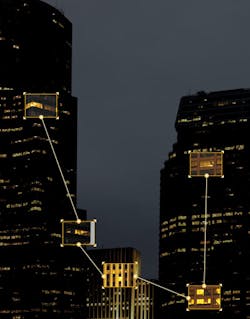On the eve of Lightfair International 2016, to be held April 26 to 28 in San Diego, the biggest news in lighting is disruption. The industry is at an inflection point — with major players exiting the chip, legacy lamp, or lighting fixture business. Because of low growth, high competition, margin erosion, and high overheads, some well-known companies are spinning-off or shutting-down divisions of their lighting business.
For example, the General Electric Co. has removed the commercial light-emitting diode (LED) business from its lighting unit, inserting it into a new company called Current that will fuse LED lighting products with GE’s solar, energy storage, and electric vehicle business and join it to GE’s growing data and analytics platform. In combination, these specialized divisions will help customers reduce energy costs in commercial buildings and other areas. This could be seen as a movement toward lighting being offered as a service rather than a product or group of products.
Control and network strategy
As energy use codes become more stringent, a network that allows luminaires to connect with each other, with sensors, and with other data collection points moves lighting from being simply a source of illumination to a source of information.
An LED lighting system can serve as a data-gathering machine that is capable of capturing, transmitting, and analyzing vast amounts of environmental happenings and transforming this data into a strategic asset that can be acted upon. Fitted with a microprocessor along with motion, photo, audio, environmental, and water sensors — making them capable of counting and collecting data about actions, temperatures, humidity, carbon dioxide levels, rainfall, wind, sound, and other conditions — the LED-based luminaire is poised to become a major service provider.
The Internet — more specifically, the Internet protocol (IP) — is increasingly the avenue for integrating these multiple applications into a lighting system. For that reason, major lighting companies are forging partnerships with Silicon Valley stalwarts to add communication/control, surveillance, verification, dimming, occupancy/vacancy control, daylight sensing, color shift, HVAC control, and more to fixtures.
For example, Philips Lighting has deals with Cisco, SAP, and Bosch, relative to the firm’s office lighting systems, street lighting networks, and its connected lighting platform for the home and hospitality market, respectively. In the office lighting arena, luminaires equipped with sensors will use Power-over-Ethernet (PoE) distribution combined with Cisco’s network technology. The Philips and SAP partnership brings sensing and control to street lighting poles, allowing streetlights to collect information on noise, temperature, wind, and air pollution, while also using cameras to analyze traffic and parking flows and provide greater security.
Specifications and standards
Government regulations continue to call for more energy-efficient buildings, paving the way for increased adoption of the LED light source in the United States. The American Society of Heating, Refrigerating, and Air-Conditioning Engineers (ASHRAE) 90.1 Standard and California’s 2014 update to its Title 24 Energy Efficiency Standards are important references for lighting control specifiers today. However, the lack of standards in the lighting industry inhibits adoption of advanced light controls and the collection of data for analysis and energy savings. Disparate and proprietary software systems also make it more difficult to bring diverse control schemes together, which standardization can help solve.
An important development in helping the wireless protocol standardization process is the recent announcement from the ZigBee Alliance regarding the ratification of ZigBee 3.0, a single new standard that unifies its existing wireless standards. It is also linking the EnOcean Alliance’s hundreds of energy-harvesting products with the new 3.0 standard, since the ZigBee Alliance believes it will help develop connected lighting in so-called intelligent buildings, smart homes, and smart cities.
The EnOcean Alliance, a consortium of more than 350 companies, has been developing battery-less, energy-harvesting wireless solutions for 14 years in radio frequency bands below the 1 GHz range. But demand from the marketplace to move to a worldwide frequency and enable new applications led the EnOcean Alliance to offer a 2.4-GHz energy-harvesting wireless solution, and ZigBee is an obvious choice. Essentially, the EnOcean Equipment Profiles (EEPs) and compliant products will be supported in the ZigBee 3.0 specification.
Health and wellness
At last year’s Lightfair show, “human-centric lighting” or “biological specific lighting” [i.e., having a lighting system improve the performance and well-being of people by delivering specific wavelengths (color)] received a lot of attention The spectral content of light as well as the light level throughout the day — imitating the daylong presence of sunlight — may help our biological clock (or circadian rhythm) to stay in sync. There may also be connections between ambient light, various human physiological systems, and behavioral response. However, the International Commission on Illumination (CIE) recently issued a statement that lighting professionals are far from being able to specify wellness lighting products to achieve health benefits. Nevertheless, Mark Rea, the director of the Lighting Research Center at the Rensselaer Polytechnic Institute, would like to see the evolution of lighting design move toward health, safety, and productivity — recognizing that quality is highly dependent on each application. He also calls for the adoption of metrics for circadian lighting, incorporating brightness, color, and duration to light, and a more accurate evaluation of color rendering properties of light sources, notably LEDs.
A new measurement
While the LED source offers many performance benefits, its shortcomings regarding color rendering accuracy are well known. And the use of the Color Rendering Index (CRI) to characterize the color accuracy of non-incandescent sources has not worked well with solid-state lighting. As a solution, last year, the Illuminating Engineering Society of North America (IES) published a new Technical Memorandum — TM-30-15, entitled “IES Method for Evaluating Light Source Color Rendition” — to replace the CRI color samples. The new TM relies on a set of color samples that is more representative of real-world objects as opposed to the pastel samples in the CRI metric. While it is hoped that the new method will accurately characterize both LED-based solid-state lighting (SSL) and legacy sources, publication of TM-30-15 does not automatically make it an industry standard, because the CIE — the standards body behind CRI — will also have a say in the matter.
Communicating with light
SSL is finding uses beyond general lighting as LEDs control the electromagnetic spectrum; one example is having telecommunications use a portion of the spectrum to do double duty. Last year, General Electric, Philips, and Acuity Brands separately introduced an optical wireless communications system called Visual Light Communications (VLC), which offers indoor mapping and navigation capability using the general overhead lighting system as the communications medium. VLC varies the intensity of the light output from a ceiling-mounted luminaire to send a coded signal (rapid light pulses) to the camera of a smartphone carried by a shopper. It is mono-directional from the light to the phone, operating only when the user needs it. The VLC system can help guide customers to products within the store, determine traffic patterns, and optimize the location of retail products, thus serving as an indoor version of what GPS does for the outdoor world.
With more than 60% of mobile shoppers using smartphones while in-store and 85% of consumers using retailers’ native apps or other websites during shopping trips, retailers can now use a lighting system that’s capable of providing marketing assistance. Additionally, the delivery of data via light may develop into truly “Li-Fi” communication systems for commercial offices and other venues.
New words, new concepts
SSL is a disruptive and subtly destructive force because it involves new manufacturers, a new language of lighting, and a new blend of lighting and technology. But new types of sources, exceeding the parameters of the LED, may shake up the market. Here are a few you should know about:
The organic LED (OLED) light source, which has been around for a while, may never get to compete head to head with LEDs. Nevertheless, the ability of OLEDs to provide low-level diffuse light in new types of luminaires appeals to lighting designers and architects. While OLED manufacturing costs remain one of the major hurdles to overcome, OLEDs should find a home somewhere in the lighting landscape.
Quantum dot LEDs may be the “next big thing,” perhaps because this source offers pure color while delivering 30% to 40% greater luminance efficiency than OLEDs with twice the power efficiency of OLEDs. In addition, they are ultra-thin, transparent, and flexible –– enabling designers to create new displays and lighting forms.
Laser-based lighting options might be the next generation of lighting, since a laser diode in combination with inorganic phosphors can create a high-power white light. The research is based on existing LEDs, and the product is called a “laser diode.” In one case, a blue laser diode excites yellow-emitting phosphor to achieve a luminous flux of 252 lumens, which is comparable to current high-brightness white LEDs. In another case, a near-ultraviolet laser diode excites a combination of red-, green-, and blue-emitting phosphors. Imagine using a handful of tiny but powerful lasers and then redirecting their light into fiber-optic cable and other types of light transmitting material that evenly distribute the light as a warm diffuse glow.
About the Author
Joseph R. Knisley
Lighting Consultant
Joe earned a BA degree from Queens College and trained as an electronics technician in the U.S. Navy. He is a member of the IEEE Communications Society, Building Industry Consulting Service International (BICSI), and IESNA. Joe worked on the editorial staff of Electrical Wholesaling magazine before joining EC&M in 1969. He received the Jesse H. Neal Award for Editorial Excellence in 1966 and 1968. He currently serves as the group's resident expert on the topics of voice/video/data communications technology and lighting.


